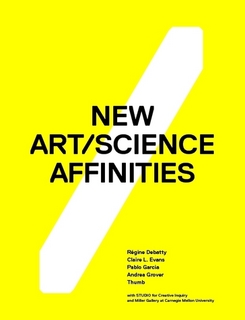Grover, Debatty, Evans, Garcia, Thumb: New Art/Science Affinites (2011)
Filed under sprint book | Tags: · art, bio art, biotechnology, hacking, maker culture, media art, programming, science, subversion, technology

The Miller Gallery at Carnegie Mellon University and the STUDIO for Creative Inquiry have co-published “New Art/Science Affinities,” a 190-page book on contemporary artists that was written and designed in one week by four authors (Andrea Grover, Régine Debatty, Claire Evans and Pablo Garcia) and two designers (Luke Bulman and Jessica Young of Thumb).
“New Art/Science Affinities,” which focuses on artists working at the intersection of art, science and technology, was produced by a collaborative authoring process known as a “book sprint.” Derived from “code sprinting,” a method in which software developers gather in a single room to work intensely on an open source project for a certain period of time, the term book sprint describes the quick, collective writing of a topical book.
The book includes meditations, interviews, diagrams, letters and manifestos on maker culture, hacking, artist research, distributed creativity, and technological and speculative design. Chapters include Program Art or Be Programmed, Subvert! Citizen Science, Artists in White Coats and Latex Gloves, The Maker Moment and The Overview Effect.
Sixty international artists and art collaboratives are featured, including Agnes Meyer-Brandis, Atelier Van Lieshout, Brandon Ballengée, Free Art and Technology (F.A.T.), Rafael Lozano-Hemmer, The Institute for Figuring, Aaron Koblin, Machine Project, Openframeworks, C.E.B. Reas, Philip Ross, Tomás Saraceno, SymbioticA, Jer Thorp, and Marius Watz.
The authors collectively wrote and designed the book during seven, 10-14 hour-days in February 2011 at the STUDIO for Creative Inquiry. During their sessions they held conversations with CMU faculty, staff and students from the STUDIO, Miller Gallery, College of Fine Arts, Robotics Institute, Machine Learning Department and BXA Intercollege Degree Program.
“The book sprint method was adopted in order to understand this very moment in art, science and technology hybrid practices, and to mirror the ways Internet culture and networked communication have accelerated creative collaborations, expanded methodologies, and given artists greater agency to work fluidly across disciplines,” says lead author Andrea Grover.
The publication is part of Grover’s Andy Warhol Foundation for the Visual Arts Curatorial Research Fellowship at CMU’s STUDIO for Creative Inquiry and Miller Gallery. “Intimate Science,” an exhibition that will be the product of Grover’s research, will take place in early 2012 at the Miller Gallery.
Published by Miller Gallery at Carnegie Mellon University + CMU STUDIO for Creative Inquiry, October 2011
ISBN 0977205347
190 pages
Licensed under Creative Commons Attribution-NonCommercial-NoDerivs 3.0 License
commentary (We-Make-Money-Not-Art.com)
authors
Michal Šimonfy: Bio – Art (2011) [Slovak]
Filed under thesis | Tags: · bio art, bioethics, biotechnology, genetics, nature, simulation, wetware

Diplomová práca mapuje rôzne umelecké prístupy, ktoré si za oblasť svojho záujmu zvolili skúmanie živej prírody, predovšetkým s prihliadnutím na jej vnútornú, biologickú či genetickú podstatu. Samostatnú časť práce tvoria príklady umeleckých stratégií spájajúce umenie, vedu a biotechnológie, pričom problematike genetického výskumu a vyvstávajúceho nového vzťahu medzi človekom, prírodou a technológiami je venovaná druhá kapitola práce, dôrazom na ich možné spoločenské, etické či politické dôsledky.
Diplomová práca
Akadémia umení v Banskej Bystrici, Fakulta výtvarných umení, Katedra Intermédií a digitálnych médií
Vedúci práce: MgA. Michal Murin ArtD.
Školiteľ: PhDr. Katarína Rusnáková, Ph.D.
Banská Bystrica: FVU AKU 2011
68 strán
viac (vrátane informácií o praktickej časti práce)
Comment (0)George Gessert: Green Light: Toward an Art of Evolution (2010)
Filed under book | Tags: · aesthetics, art, bio art, biotechnology, ecology, evolution, hybrids, kitsch

Humans have bred plants and animals with an eye to aesthetics for centuries: flowers are selected for colorful blossoms or luxuriant foliage; racehorses are bred for the elegance of their frames. Hybridized plants were first exhibited as fine art in 1936, when the Museum of Modern Art in New York showed Edward Steichen’s hybrid delphiniums. Since then, bio art has become a genre; artists work with a variety of living things, including plants, animals, bacteria, slime molds, and fungi. Many commentators have addressed the social and political concerns raised by making art out of living material. In Green Light, however, George Gessert examines the role that aesthetic perception has played in bio art and other interventions in evolution.
Gessert looks at a variety of life forms that humans have helped shape, focusing on plants—the most widely domesticated form of life and the one that has been crucial to his own work as an artist. We learn about Onagadori chickens, bred to have tail feathers twenty or more feet long; pleasure gardens of the Aztecs, cultivated for intoxicating fragrance; Darwin’s relationship to the arts; the rise and fall of eugenics; the aesthetic standards promoted by national plant societies; a daffodil that looks like a rose; and praise for weeds and wildflowers. Gessert surveys recent bio art and its accompanying philosophical problems, the “slow art” of plant breeding, and how to create new life that takes into account what we know about ecology, aesthetics, and ourselves.
Publisher MIT Press, 2010
Leonardo Books series
ISBN 0262014149, 9780262014144
233 pages

